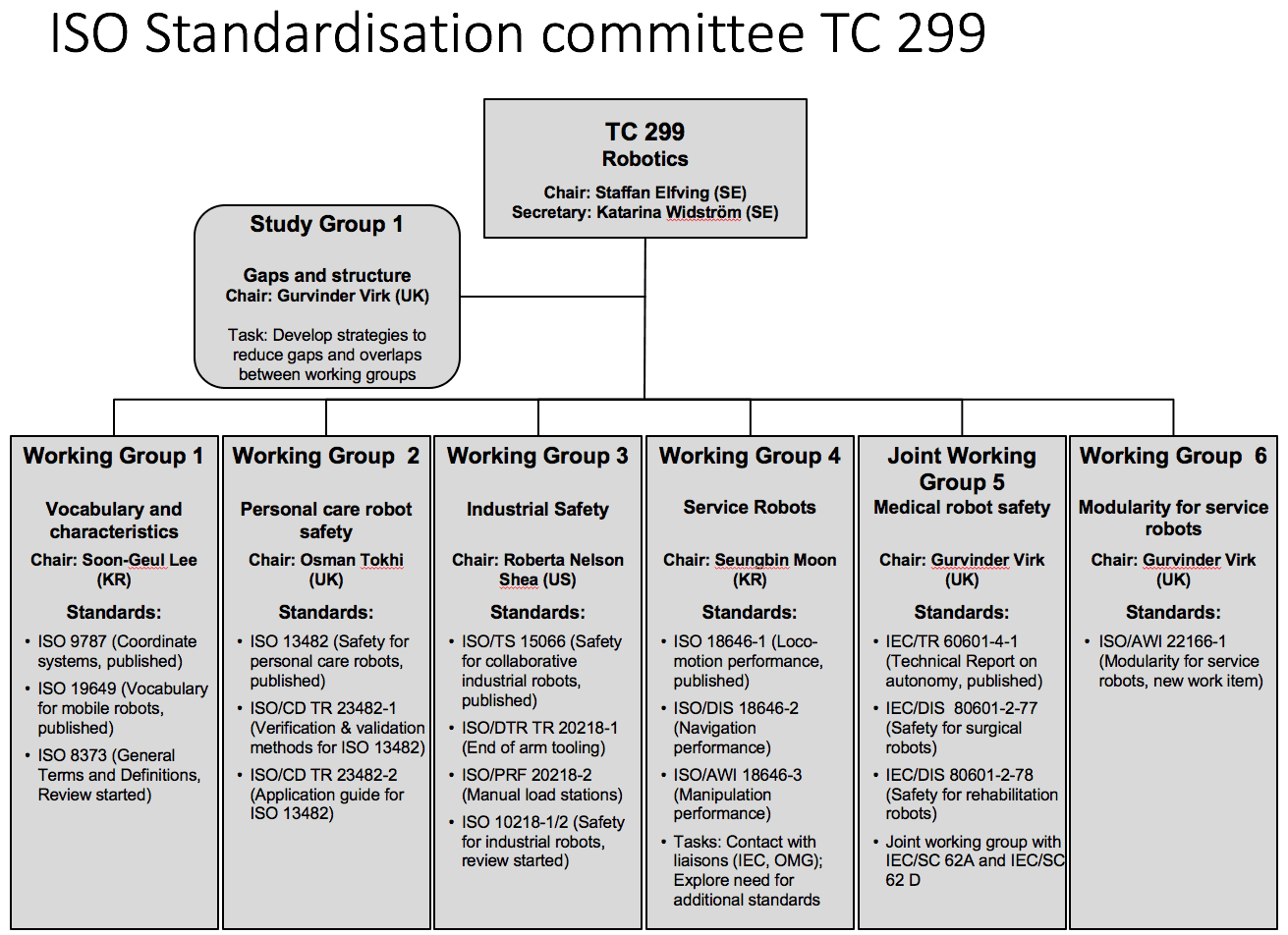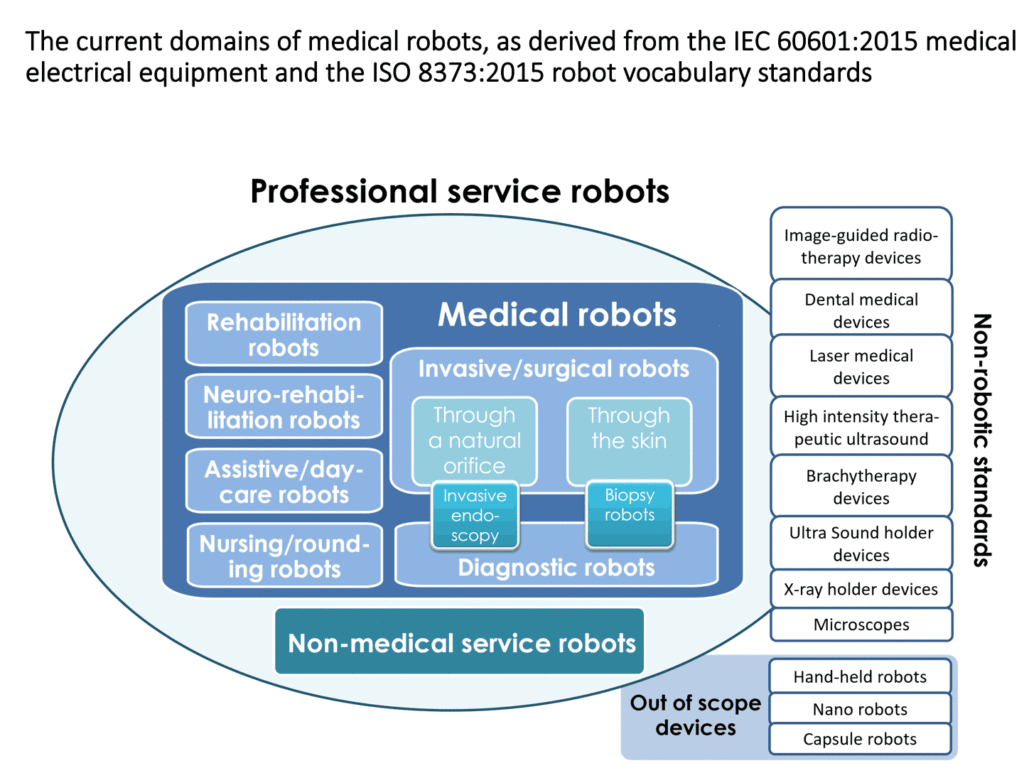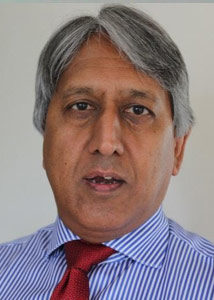Since the early 1990s, Standard Development Organizations have been releasing robotics standards. Yet, given the unprecedented pace of advancement in this field, SDOs are in a very challenging position to regulate rising domains which evolve much faster than the traditional creation cycle of a technical standard. The first IEEE robotic standard came out late (P1872, 2015), born into a rapidly evolving robot standardization environment, mostly outlined by the work of the International Organization Standardization (ISO) and International Electrotechnical Commission (IEC). It is important to recognize the work that has been done by these SDOs, and review the current hot areas to better understand the landscape of robot standards.

- ISO 9787 – Robots and robotic devices – Coordinate systems and motion nomenclatures (published in 2013)
- ISO 19649 – Robots and robotic devices – Vocabulary for mobile robots (published in 2016)
- ISO 8373 – Robots and robotic devices – Vocabulary (published in 2012, scheduled for periodic review)
WG 1 is maintaining robot-related definitions and terminology which are used in the different working groups in TC 299. Fundamental definitions are the terms “robot”, “robotics”, “robotic technology” and “autonomy” which are used in the title and scope of the robotics standardization committee. As especially the market for service robots is still emerging, these definitions are not considered to be final, but are expected to be adjusted from time to time as necessary. With the recently initiated review process of ISO 8373, WG 1 will coordinate a systematic review of the definitions with the goal to ensure that the terminology is fit for future standards and working groups. This will also include a categorization of robots based on their mechanical structure, task and application domain which will allow the exact shaping of scopes for standards and working groups.
Apart from basic terminology, WG 1 is dealing with other vocabulary for certain domains such as navigation or perception and has published ISO 19649 in the beginning of 2017. The standard defines terminology for mobile robots such as the definitions of wheel types and undercarriage structures. During the last meeting in Suzhou WG 1 has started the revision of ISO 8373.
- ISO 13482 – Robots and robotic devices – Safety requirements for personal care robots (published in 2014)
- ISO/CD TR 23482-1 –Technical report: Validation criteria for personal care robots (committee draft)
- ISO/CD TR 23482-2 – Application guide for ISO 13482 to be published as a technical report (committee draft)
WG 2 has the task to develop safety standards for “personal care robots” – earthbound robots in direct interaction with the human and contributing directly to his/her well-being. Three robot types representing the personal care robot, “mobile servant robots”, “person carrier robots” and “physical assistant robots” were identified and serve as examples in the standard ISO 13482. With respect to the special situation that personal care robots act in direct vicinity of the user and that the autonomy of these robots is generally high, some clauses were added, that are unique in machinery safety, such as instructions dealing with incorrect autonomous actions and decisions.
During the last meeting in Suzhou, the working group continued developing two guidance documents which will help manufacturers to apply the standard and to verify compliance of their products. In the technical report ISO TR 23482-1 that is currently under preparation, measures for verification and validation are described which can be used by robot manufacturers for safety testing. Tests include stability tests for different travel patterns (e.g. on ramps or while accelerating or stopping), but also impact tests with crash test dummies. A second technical report, ISO TR 23482-2, provides guidance on how to perform risk assessment and risk reduction for personal care robots.
When these two technical reports are published, WG 2 will start the systematic review of ISO 13482. Most likely this will include splitting up the standard into several parts, so that each robot type can be maintained in a separate document and new robot types can easily be added.
- ISO 10218-1 – Robots and robotic devices – Safety requirements – Part 1: Robots (published in 2011, periodic review started)
- ISO 10218-2 – Robots and robotic devices – Safety requirements – Part 2: Robot systems and integration (published in 2011, periodic review started)
- ISO TS 15066 – Robots and robotic devices – Safety requirements for industrial robots – Collaborative operation (published in 2015)
- ISO/DTR TR 20218-1 – Robots and robotic devices – Safety requirements for industrial robots – Part 1: Industrial robot system end of arm tooling (end-effector) (new work item)
- ISO/PRF 20218-2 – Robots and robotic devices – Safety requirements for industrial robots – Part 2: Industrial robot system manual load stations (committee draft)
WG 3 is dealing with the safety of industrial robots. After the technical specification ISO TS 15066 which provides extended requirements for human–robot collaboration and specifies limits for impact forces and pressures, WG 3 developed two new work items. One is a technical report on the safety of manual load stations, i.e. stations where a worker hands over a part directly to a robot end effector (e.g., a gripper). In addition, a guidance document is developed on the safety of industrial robot end effectors.
WG 3 is also in the process of doing a systematic review of ISO 10218-1 and -2 which have now reached an age of 5 years. During the update process, it is intended to integrate content from ISO TS 15066 into these standards.
- ISO 18646-1 – Robots and robotic devices – Performance criteria and related test methods for service robot – Part 1: Locomotion for wheeled robot (publication by the end of 2016)
- ISO/DIS 18646-2 – Robots and robotic devices – Performance criteria and related test methods for service robot – Part 2: Navigation (committee draft)
- ISO/AWI 18646-3 – Robots and robotic devices – Performance criteria and related test methods for service robot – Part 3: Manipulation (new work item)
- Add. Task: Determining need for additional standards for service robots
WG 4 is engaged in developing standards on robot performance. In order to compare the performance of functions like path-finding, object recognition or the ability to move on difficult terrain, standardized test methods are necessary. The first standard, ISO 18646-1 for measuring locomotion performance, was published in 2016. The second part, ISO 18646-2 on navigation performance is also close to publication and includes e.g. test setups for measuring path repeatability of the turning width of a mobile robot. A third part dealing with manipulation performance is has recently been started. In addition, WG 4 has since many years the special task to monitor the development on the service robot market in order to identify the need for additional standards for service robots. In the last years, several liaisons have been established with IEC, because the development of standards for autonomous vacuum cleaners and lawn-mowers has been initiated there.
- IEC/TR 60601-4-1 – Medical electrical equipment – Part 4.1: Guidance and interpretation – Medical electrical equipment and medical electrical systems employing a degree of autonomy (published)
- IEC/DIS 80601-2-77 – Medical Electrical Equipment – Part 2-77: Particular requirements for the basic safety and essential performance of medical robots for surgery (committee draft)
- IEC/DIS 80601-2-78 – Medical Electrical Equipment – Part 2-78: Particular requirements for the basic safety and essential performance of medical robots for rehabilitation, compensation or alleviation of disease, injury or disability (committee draft)
Other than industrial robots and (non-medical) service robots, robots used for healthcare purposes have to fulfil safety requirements for medical devices instead of or in addition to requirements for machinery safety. With this possible conflict in mind, a joint working group (JWG) between ISO TC 299 (responsible for robot safety) and IEC SC 62 A (responsible for medical electrical equipment safety) was founded in 2010. The JWG spent quite some time on evaluating the boundaries and requirements for the new standards. As a first result, a technical report providing guidance on medical equipment with autonomous functions, ISO 60601-4-1 was published in 2017. The committee outlined the various sub-domains of medical robots being affected by the new standards.
 In 2015, two subgroups were founded inside JWG 5 with IEC SC 62D. The first subgroup (JWG 35) is developing a standard for basic safety and essential performance of robots for surgery, IEC 80601-2-77. The second subgroup (JWG 36) is dealing with medical robots used for rehabilitation and has started the development of IEC 80601-2-78. Recently, in 2017, both documents have reached the status of Draft International Standards (DIS), now being circulated for final voting among member states.
In 2015, two subgroups were founded inside JWG 5 with IEC SC 62D. The first subgroup (JWG 35) is developing a standard for basic safety and essential performance of robots for surgery, IEC 80601-2-77. The second subgroup (JWG 36) is dealing with medical robots used for rehabilitation and has started the development of IEC 80601-2-78. Recently, in 2017, both documents have reached the status of Draft International Standards (DIS), now being circulated for final voting among member states.
ISO WD 22166-1 – Robotics – Part 1: Modularity for service robots – Part 1: General requirements WG 6 has the task to prepare the development of a new standard for interoperability and reusability of robotic components on mechanical, electrical and software levels. WG 6 is currently working on its first work item to create safety requirements and guidance for service robot modularity. The goal of the standard is to provide guidance to manufacturers who want to develop their own modular architecture. Key sections being developed include
- Definitions
- Generic modularity issues (including connectivity, inter-operability and safety at the module level)
- Safety and security issues of modular systems
- Frameworks for hard- and software
- Key robotic components
During the last meeting in Suzhou, the working group finished a series of changes originating from the new work item balloting and prepared the document for the committee draft ballot.
Apart from these, ISO is continuously looking into the revision and amendment of its existing robot standards, and looking into co-operations to align with similar domains (e.g., standards for self driving cars, currently guided by vehicle standards within ISO). One prime example for that is the establishment of the SG1 (study group 1), which is solely focusing on the gaps and inconsistencies between the output of the existing WGs, so their future work can be better focused and streamlined.
It is clear that robotics is evolving from its industrial manufacturing roots at an increasing rate and new robot use cases are emerging. The new robot application sectors are posing new challenges for standardization and ISO and IEC have reacted rapidly over the past 10 years or so to create new working groups to develop the needed standards, especially those related to safety. The foremost aim of international standardization is to facilitate the exchange of goods and services through the elimination of technical barriers to trade. The process of standardization, and especially the organization of the working group meetings is a voluntary effort of the international experts devoted to robotics, where international peers from the Academia, Industry and Government can work together toward clear targets. With the increasing usage of robots, the needs for standardized solutions has intensified. The focus of ISO TC 299 is to identify and address these needs related to all robotics disciplines, preferably in a collaboration with other SDOs and professional organizations, like IEEE. The new robot domains are giving rise to boundary and overlap issues and where one type of robot ends and another starts; for example when does a physical assistant exoskeleton robot governed by WG2 become an industrial robot governed by WG3. SG1 has recently been set up address such issues and help provide recommendations on how to organize future robot standardization projects. Also gaps in robot standardization projects are to be identified.
This contribution is partly based on work in the H2020 Coordination and Support Action “RockEU 2” (GAN 688441, see www.eu-robotics.net) and the COST Action CA16116 “Wearable Robots for Augmentation, Assistance or Substitution of Human Motor Function”, supported by COST (European Cooperation in Science and Technology), see https://wearablerobots.eu.
T. Haidegger is supported by the Hungarian OTKA PD 116121 grant. His work has been supported by ACMIT (Austrian Center for Medical Innovation and Technology), which is funded within the scope of the COMET (Competence Centers for Excellent Technologies) program of the Austrian Government. T. Haidegger is supported through the New National Excellence Program of the Ministry of Human Capacities. This work was partially supported by the Hungarian EFOP-3.6.2-16-2017-00016 grant.
 Theo Jacobs received his degree in Mechanical Engineering from Leibniz University Hannover in 2008. Since then he is working as project manager at Fraunhofer IPA, focused on mechanical engineering in the field of mobile service robots for industrial and domestic use as well as the safe design of such robots. Since 2009 he is a technical expert in the ISO standardization committee TC 299 where he is engaged in the development of standards for service robots. Since 2014 Theo Jacobs is responsible for the dissemination of standardization results and attraction of new technical experts within the European Coordination actions euRobotics (FP7), RockEU (FP7) and RockEU 2 (H2020).
Theo Jacobs received his degree in Mechanical Engineering from Leibniz University Hannover in 2008. Since then he is working as project manager at Fraunhofer IPA, focused on mechanical engineering in the field of mobile service robots for industrial and domestic use as well as the safe design of such robots. Since 2009 he is a technical expert in the ISO standardization committee TC 299 where he is engaged in the development of standards for service robots. Since 2014 Theo Jacobs is responsible for the dissemination of standardization results and attraction of new technical experts within the European Coordination actions euRobotics (FP7), RockEU (FP7) and RockEU 2 (H2020).
 Jan Veneman, received his degrees from the University of Twente, in Mechanical Engineering (MSc 1999), PSTS (MSc 2002), and Biomedical Engineering (PhD 2007). Currently he works in the Medical Robotics Application Area of the Health Division, Tecnalia Research, and Innovation, Spain. He is project manager and senior researcher on rehabilitation robots and wearable robots. Since 2013 he is coordinating the EC-FP7 consortium research Project BALANCE, on the development of a robotic exoskeleton with self-balancing control. He was elected Action Chair of COST Action 16116 on Wearable Robots and is active since 2012 as national delegate in several ISO and IEC standardization working groups related to medical robotics, especially exoskeletons.
Jan Veneman, received his degrees from the University of Twente, in Mechanical Engineering (MSc 1999), PSTS (MSc 2002), and Biomedical Engineering (PhD 2007). Currently he works in the Medical Robotics Application Area of the Health Division, Tecnalia Research, and Innovation, Spain. He is project manager and senior researcher on rehabilitation robots and wearable robots. Since 2013 he is coordinating the EC-FP7 consortium research Project BALANCE, on the development of a robotic exoskeleton with self-balancing control. He was elected Action Chair of COST Action 16116 on Wearable Robots and is active since 2012 as national delegate in several ISO and IEC standardization working groups related to medical robotics, especially exoskeletons.
 Gurvinder S. Virk received BSc in Electronics Engineering from University of Manchester and a PhD in Control theory from Imperial College, University of London, UK. His current research interests are in personal care robots, wearable exoskeletons, medical robots, climbing and walking robots, robot safety standardisation, and robot modularity. He is Technical Director of Innovative Technology and Science Limited and Trustee of CLAWAR. He has held senior academic positions in UK (Universities of Bradford, Portsmouth and Leeds), Sweden (University of Gavle and KTH), New Zealand (Massey University) as well as visiting positions in China (Zhejiang University), France (Université Pierre et Marie Curie, Paris), Germany (Fachochschule Südwestfalen, Soest) and India (IIT Ropar). He has produced over 350 publications in these areas, supervised 16 successful PhD students, as well as secured external research funding of over $25M. He is a leading actor in international robot standardisation and holds several leadership positions in several robot standardisation groups. He is on the Editorial Board of several scientific journals including Industrial robot, Robotics and autonomous systems, Intech International Journal of Advanced Robotic Systems, and ISRN Robotics, Advances in robotics and automation and Journal of Robotics and mechanical engineering research.
Gurvinder S. Virk received BSc in Electronics Engineering from University of Manchester and a PhD in Control theory from Imperial College, University of London, UK. His current research interests are in personal care robots, wearable exoskeletons, medical robots, climbing and walking robots, robot safety standardisation, and robot modularity. He is Technical Director of Innovative Technology and Science Limited and Trustee of CLAWAR. He has held senior academic positions in UK (Universities of Bradford, Portsmouth and Leeds), Sweden (University of Gavle and KTH), New Zealand (Massey University) as well as visiting positions in China (Zhejiang University), France (Université Pierre et Marie Curie, Paris), Germany (Fachochschule Südwestfalen, Soest) and India (IIT Ropar). He has produced over 350 publications in these areas, supervised 16 successful PhD students, as well as secured external research funding of over $25M. He is a leading actor in international robot standardisation and holds several leadership positions in several robot standardisation groups. He is on the Editorial Board of several scientific journals including Industrial robot, Robotics and autonomous systems, Intech International Journal of Advanced Robotic Systems, and ISRN Robotics, Advances in robotics and automation and Journal of Robotics and mechanical engineering research.
 Tamas Haidegger, received his degrees from the Budapest University of Technology and Economics (BME) in Electrical Engineering and Biomedical Engineering (MS EE 2006, MS BE 2008, PhD EE, 2011). His main field of research is control/teleoperation of surgical robots, image-guided therapy and supportive medical technologies. Currently, he is an associate professor at the Óbuda University, serving as the deputy director of the Antal Bejczy Center for Intelligent Robotic. Besides, he is a research area manager at the Austrian Center of Medical Innovation and Technology (ACMIT), working on minimally invasive surgical simulation and training, medical robotics and usability/workflow assessment through ontologies. Tamás is an active member of various other professional organizations, including the IEEE Robotics an Automation Society, IEEE SMC, IEEE EMBC and euRobotics aisbl. He is a national delegate to an ISO/IEC standardization committee focusing on the safety and performance of medical robots.
Tamas Haidegger, received his degrees from the Budapest University of Technology and Economics (BME) in Electrical Engineering and Biomedical Engineering (MS EE 2006, MS BE 2008, PhD EE, 2011). His main field of research is control/teleoperation of surgical robots, image-guided therapy and supportive medical technologies. Currently, he is an associate professor at the Óbuda University, serving as the deputy director of the Antal Bejczy Center for Intelligent Robotic. Besides, he is a research area manager at the Austrian Center of Medical Innovation and Technology (ACMIT), working on minimally invasive surgical simulation and training, medical robotics and usability/workflow assessment through ontologies. Tamás is an active member of various other professional organizations, including the IEEE Robotics an Automation Society, IEEE SMC, IEEE EMBC and euRobotics aisbl. He is a national delegate to an ISO/IEC standardization committee focusing on the safety and performance of medical robots.
